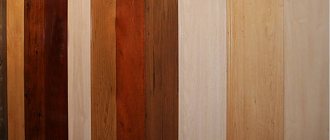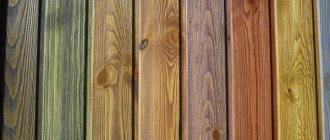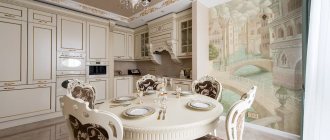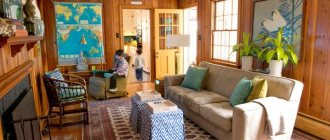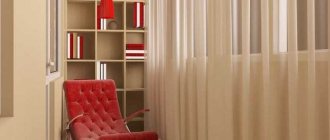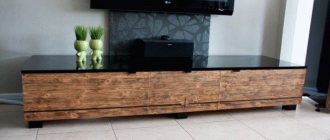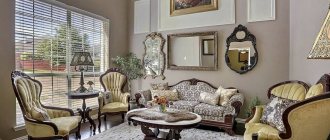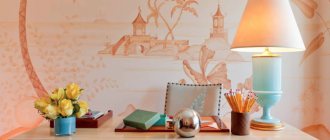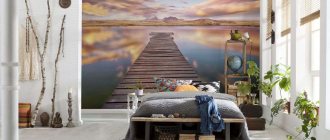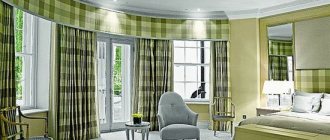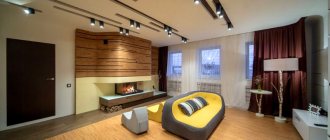Lumber has always been divided into grades. Classes and types, depending on the quality of processing, type of wood, and the shape that is cut from the log. Shtil lining belongs to the premium class of building materials. It is made from hard hardwood and has a number of advantages over other types of wooden lining.
In order to understand the “calm” feature, it is necessary to understand the typology of materials. The main characteristics of any wooden lining can be called:
- Density of wood (material of manufacture);
- Type of front surface (matte, glossy, pattern);
- Product class (processing quality);
- Lock type (connecting projections along the side of the lamella);
- Durability, wear resistance.
Most materials on the market come with minor defects and belong to class 1-2 materials. Common species: alder, Siberian larch, pine and others have low wear resistance and become unusable after 4-6 years of use. In addition, a poorly processed lock leads to destruction of the slats from the inside, which also adversely affects the service life, appearance, and safety of the home.
When producing lining, calm eliminates these disadvantages.
It is made using high quality tools and the best wood.
Raw materials for production
For production, well-dried oak blanks are used. Sawing, grinding, and turning the lock take place at normal humidity in a warm room, which prevents bending or twisting of the wood during processing.
Oak is a very hard, expensive, beautiful wood. The cut has a beautiful pattern, the density of the wood practically eliminates damage to the surface by physical or thermal effects.
Premium class Shtil lining is produced at several factories in Russia, and it is also imported from other countries. The high price per unit of lamella is justified by the high strength characteristics. Even when stored in warehouses with unsatisfactory conditions, the sheets retain their shape and appearance.
Front surface type
Processing the lining with calm creates a material with which you can very easily create a solid, smooth surface. It is now possible to assemble a wall without a single joint.
The glossy surface, with the help of a special lock, is assembled into a smooth plane. There are no joints or gaps between the slats - a tight fit and additional polishing will create a beautiful and safe interior for any type of room. Calm lining can be used for finishing both service and hygienic premises, such as a bathhouse or sauna, and for living rooms, children's rooms, and dining rooms.
Calm lining looks decent in the interior. Coating with different types of varnish will add shine and the necessary shade to the overall palette. Examples can be seen in the photo.
What it is?
Lining is a profiled board for cladding walls indoors and outdoors, coated with antiseptic compounds.
Clapboard panels differ in several ways.
- According to wood material. The lining can be made from coniferous or deciduous wood. The strength, color, texture, and durability of the panels depend on the type of wood.
- By wood class. Class “A” is considered the best; the material for making boards in this case does not contain defects, and there are no areas of high humidity. In class “B” these defects may be present in small quantities. Class “C” is low quality wood with areas of rot, knots and cracks.
- By profile. There are several types of profiles: regular, eurolining, American, block house, lining for logs, for timber, “calm”.
“Calm” is a profile of lining panels for cladding, which quickly and easily allows you to mount an almost perfectly flat wall. This facing material looks beautiful and will fit harmoniously into any interior. The solidity of the surface is achieved thanks to the panel joint and the rounded chamfer at the edges of the product. There is no connecting shelf, unlike conventional lining.
Along the entire length of the panel in the “calm” lining there is a special groove to ensure free access of air. This allows, through ventilation, to get rid of excess moisture in the wood resulting from the formation of condensation. During operation, such lining performs better.
Processing quality
Tools for high-precision wood processing are used at every stage of creating lamellas. Grinding is done with fine sandpaper, the locks are turned with a special high-precision cutter on an automated machine. The finishing coating and adjustment of the lamellas serve to produce identical lamellas, which differ only in the pattern on the front side.
The high quality of processing makes Calm not only a desirable material for wall decoration, but also a raw material for creating furniture, design projects, smooth table coverings, work surfaces, etc.
Lock type and characteristics
For thick types of wood, such as oak, ash, hornbeam, beech, a simple but effective tongue-and-groove lock is used. Oak lining of the Shtil brand also uses this type of fastener, the design of which combines two features: a tight fit of the lamellas to one another to create a smooth front side, a place for attaching hidden fasteners.
When assembling walls from lamellas, the plates fit into each other with little effort. Often, for a better fit, the stil lining is laid like a laminate - using a consumable piece of lamella and a mallet.
What it is?
The cost of natural materials is high; everyone cannot afford to buy them. The use of Shtil lining is an excellent choice from the entire variety of products on the market. Let’s take a look at what it is and what parameters characterize this finishing method.
The lining looks like classic boards used for cladding , made from natural raw materials. To make the Shtil lining, pine, cedar, birch, linden, and other wood bases are used. This finish differs from other varieties in the absence of recesses along the edges of the panel. To connect parts of the cladding, tongue-and-groove fastenings are provided here. The technology allows you to create an even and smooth surface decor with an accurate imitation of solid wood.
Durability of finishing
If the sheets are installed correctly, the coating can last more than 8-10 years without losing its strength or deteriorating in appearance.
Several reasons affect the service life of the Shtil lining:
- Durable type of wood (oak);
- Absence of the slightest knots, cracks, chips in the lamellas;
- Coating with high-quality antiseptic agents;
- Redistribution of internal stress over the entire plane of the wall.
The lining creates a monolithic coating that can withstand both physical influences and changes in temperature, humidity, in rooms with a special microclimate: saunas, relaxation rooms, smoking rooms, etc.
Varieties
The “calm” lining is divided into grades according to its quality. The grade is determined depending on the class of raw materials used, the appearance of the front side, the number of knots per 1.5 linear meters of surface, and the type of wood. There are 4 varieties.
- “Extra” grade boards are characterized by excellent quality, high thermal conductivity and good appearance. Knot-free spliced lining is a material of this type. In this case, the wood material does not contain a single knot, the surface is smooth, clean, and there are completely no defects. The color and texture of the wood are stable. Board length up to 5 meters.
- Grade "A". In this class, 1 knot per 1.5 linear meters is allowed. Often, boards of this type of certain types of wood (pine, larch) may not differ from the highest class. The length of the board is up to 3.8 meters.
- Grade "B". There can be up to 4 knots and 2 pockets of resin per unit length of measurement. The length of the board is up to 5 meters. Most often used to cover floors.
- Grade "C". This grade is economy class lumber. There may be knots, cracks, and blue spots. Used in utility rooms, utility rooms, technical buildings. For “calm” lining such material is used extremely rarely.
Application of material
Calm lining in the interior looks very good. It can be coated with any type of paint, and therefore creating unusual projects, for example, a room made of wood with green walls, is quite possible. The main ones here are environmental friendliness, non-toxicity, and strength of the material. Water, dry heat, temperature changes and kinetic damage to oak are not dangerous, so clapboard can be used to cover problem parts of the room, namely:
- House water heating pipes;
- Problematic wiring, 360V cable;
- Secret doors, transom trim, etc.
In addition, with the help of a durable frame made of timber and lining, you can create a partition inside the room, a false wall or other similar structure.
The paneling is easy to disassemble and transport. This is one of the few types of material that can be reused for its intended purpose.
Calm lining, the dimensions and dimensions of which allow you to cover a room of any height, is sold in the number of sheets, not by footage. The uneven cut of the lamellas at home makes it almost impossible to install several levels. Selling sheets in pieces helps reduce the cost of materials for buyers and minimize waste during installation.
Running dimensions of the lining
13mm x 120mm – thickness x width of the product. These are the optimal sizes for hardwood sheets. They are easy to manufacture, transport, store and install; They are light in weight and are held firmly on the clamping brackets.
The following sheet lengths are available for purchase:
- 2000mm;
- 2500mm;
- 2700mm;
- 3000mm.
When purchasing from a factory, shorter sheets are also available - production waste, but they do not differ in the quality of processing and are only suitable. as a consumable during the preparatory stages of repair.
The available sections are well suited for finishing both standard houses (Khrushchev, Stalin and modern new buildings) and rooms with a unique design in private houses.
Angarsk pine - calm
For cladding the inside of a room, the material could not be chosen better. The properties and pattern of Angara pine will please even the most demanding owners.
These panels can be used to decorate the attic, children's room, living room and veranda.
The tree gives off an amazing pine scent . Wood is very easy to paint, so it is well suited for decoration.
Calm lining made from Angarsk pine has different widths - from 80 to 130 mm. The length of the panels varies from 2.5 to 6 meters. The most common high quality classes are Premium, Extra/
Installation features
Calm lining is quite heavy, it must be mounted on a strong wooden frame made of 3x3, 5x5 timber or 3x3 cm planks. Special requirements for the wall: in order to make a really smooth surface, the frame must be installed on a flat wall, without cracks, gaps, bulges. The preparatory stage lasts 2-3 days and includes:
- Leveling, sealing walls;
- Applying antifungal mixtures to walls and wood;
- Installation of the frame, alignment using a laser level.
On a flat frame, assembling a wall from lamellas will take only a few hours. The frame should be a horizontally installed beam with a step of 50 cm from one another. For vertical installation of lining, the timber is attached horizontally and vice versa. The lining of the calm and the profile under it must form one plane. Most of the time will have to be spent on drilling holes for self-tapping screws for clamping brackets and aligning the slats.
Installation of Shtil lining on the ceiling
Before installing Shtil lining on the ceiling, the products are allowed to rest in the room where the installation will take place for two days. During this time, the material adapts to the temperature and humidity of the room and will not deform after installation.
Attention! The panels are installed at a temperature not lower than 5°C and a humidity not exceeding 60%. Be sure to leave a gap of 1-2 mm between adjacent elements to compensate for the deformation of the material when the microclimate in the room changes.
- First we find the lowest corner in the room. In this place, we set aside the distance from the ceiling surface by which our lining ceiling is lowered.
- Using a level, we transfer the resulting mark to other corners of the room and mark a line on all the walls.
- Next, following the markings, we attach guide profiles or bars to the walls. The installation step of fasteners is 30 cm.
- Then we apply markings on the ceiling along which we will attach the ceiling profiles of the frame. The installation pitch of the profiles is 60 cm. Using the applied markings, we attach the suspensions to the ceiling.
- We install the longitudinal and transverse profiles of the frame, securing the elements to hangers and to guides on the walls.
- We check the horizontal installation of the sheathing using a level.
- We install the lining and carry out the finishing coating (paint or varnish).
Tools and materials for work
To work you will need the following tools:
- hammer drill or drill;
- screwdriver;
- metal hacksaw or scissors;
- construction level (laser or water);
- tape measure, pencil, ruler;
- saw for cutting material;
- hammer;
- stepladder or scaffolding.
From materials, in addition to the lining itself, you will need components for the manufacture of the sheathing, because the panels are attached only to a wooden or metal frame.
To install the sheathing and install the panels, stock up on the following materials:
- metal guides and ceiling profiles or wooden beams with a section of 4x4 cm;
- ceiling suspensions;
- anchors and dowels;
- self-tapping screws;
- connecting elements;
- lining;
- ceiling plinths.
Methods of fastening Shtil lining
Fastening the Shtil lining to the ceiling is carried out in several ways:
- Fixation using clamps is the most convenient and fastest way. Fasteners are attached to the sheathing using self-tapping screws or nails. The board is fixed using a clamp tooth, which is inserted into the groove of the element. In this case, the body of the board is not damaged and there is no risk of cracking.
- Fastening to the frame using self-tapping screws or nails is done through holes drilled in the groove. The fastening element is screwed into the groove of the board at an angle and recessed into the body so that its head does not interfere with the insertion of the tenon of the subsequent lamella. This method is bad because it can cause cracking and damage to the element.
- Heavy thick lining is attached to the sheathing with nails or screws through through holes in the body of the board. The caps of the fastening elements are recessed into the material, and the holes are closed with decorative inserts.
There is another way to conceal panels. Nails are driven into the sheathing half their length. The fastener caps are cut off using construction nippers. After this, the panel is carefully installed on the protruding nails and hammered on top with a mallet to fit on them. The result is a very neat surface with hidden fasteners.
Installation method
The lining can only be secured with hidden staples. Self-tapping screws, galvanized nails and other methods can damage the smooth surface. It is impossible to nail even used lining in a non-residential premises - the nail will either bend due to the excessive strength of the material or split the board itself. Self-tapping screws are a more preferable option for installing used or defective lamellas.
Hidden clamps are S-shaped. One of the planes is inserted into a groove on the lining, and the second is screwed to the frame with small self-tapping screws. For a 2500 mm long lamella, 6-8 hidden staples are required to hold the sheet firmly in place. To ensure that the finishing surface is as smooth as possible, craftsmen advise using preliminary drilling of holes for self-tapping screws, rather than screwing them in place with a self-tapping screw.
In this case, a punch or a drill bit will be a useful tool.
Caring for lining
After installation, the surface must be coated with colorless varnish or another type of protective coating. This will allow you to wash the wall with soap or alcohol-containing products.
Regular inspection for defects will quickly determine the factor of destruction. Very often the coating begins to rot not from the side of the lock, but from the side of the untreated cut.
In general, Shtil brand wooden lining, painted with oil or alkyd paints, is practically invulnerable to household dirt, dust, and non-toxic liquids.
Useful tips for the master
It is best to cut lamellas with a hand-held circular saw at high speed. This tool allows you to make an even cut without the risk of chips, cracks, or the blade moving to the side.
Treatment of wood with antiseptics, waterproofing agents and other protective agents occurs only after preliminary cutting and fitting of the lamellas.
The installation of sockets is carried out at the junction of the lamellas - this way you can avoid excessive torsion or cracks during cutting inside the board.
Many manufacturers coat their products with protective compounds before sale. This does not mean that you won’t have to apply an antiseptic to the slats - protection against moisture in a warehouse is noticeably different from antifungal protection in an apartment.
It is necessary to carefully select fastening material. Cleaver staples also differ in their characteristics. It is worth choosing wide brackets made of galvanized iron with 2-4 holes for self-tapping screws. High-quality fastening - durable coating.
Calm lining in the interior of any room is a noticeable plus for the atmosphere. Timely care and replacement of defective sheets will extend the life of the repair in the room.
Beautiful examples of cladding
Finishing the inside or facade of buildings with Shtil clapboard is one of the inexpensive ways to transform a home. The panels are manufactured using modern technologies, which increases their performance characteristics. Some types of panels do not require any care or treatment with fungicidal agents. Wood paneling is always in fashion.
Classic lining made of boards is an environmentally friendly material. It will fit well into most fashionable interiors. However, if you use this material everywhere, a peculiar dacha effect arises. Therefore, lining should be used selectively, for example, for decoration and creating fashionable accents.
Wood panels can be present in the interior decoration of walls, on the ceiling, and in other interior details.
- The possibility of painting the lining is a positive decorative advantage of this material. For example, white lining is well suited to embody a Scandinavian interior.
- Painted lining is often used for cladding facades and street elements, for example, gazebos. The painted lining inside the gazebo will retain its original qualities for a long time.
- Today, manufacturers have diversified the range of linings. In addition to classic boards for cladding, in stores you can find good and interesting materials, from the point of view of the designer. For example, the facing of overlapping boards imitates American lining.
- A block house can easily cope with imitation of log laying.
- Choose lining options in accordance with the intended design. As you can see, standard boards can be supplemented with other types of designs.
You will learn how to quickly attach the lining in the following video.
